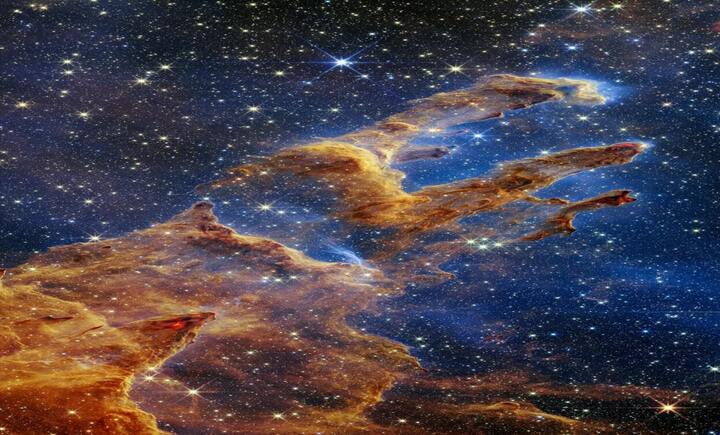NASA’s most conscientious observatory has done it once more. The James Webb Space Telescope has turned back an infrared image of the famous Pillars of Creation, which is the sharpest and the most detailed portrait of the spectacular star-forming region ever seen.

Translucent columns of cool interstellar gas and dust are punctuated by piercing, bright points of light in the ethereal scene. According to NASA, the majority of these are stars, and the reddish balls of fire near the edges of the pillars are newly created stars.
“The three-dimensional pillars look like majestic rock formations, but are far more permeable,” NASA wrote. “These columns are made up of cool interstellar gas and dust that appear – at times – semi-transparent in near-infrared light.”
Source: huffpost.com
These are not to be confused with the deep red, magma-like areas that run along the inside perimeter of a few of the pillars. This is caused by the turbulence caused by stars that are still forming and shooting supersonic jets of material into space where they collide with other materials. In a nutshell, this is how cosmic chaos appears.
Fortunately, these epic explosions and cosmological collisions are thousands (approximately 6,500 light-years) of light-years away from Earth.
NASA’S Hubble Space Telescope photographed this region of the universe for the first time in 1995. The Hubble successfully conducted a follow-up mission in 2014, and numerous other observatories have focused their telescopes on the Eagle Nebula.
“When knots with sufficient mass form within the pillars of gas and dust, they begin to collapse under their own gravity, slowly heat up, and eventually form new stars,” NASA said. “Young stars periodically shoot out supersonic jets that collide with clouds of material, like these thick pillars … The crimson glow comes from the energetic hydrogen molecules that result from jets and shocks. This is evident in the second and third pillars from the top – the NIRCam image is practically pulsing with their activity.”
Source: huffpost.com
A side-by-side comparison of the new photo and Hubble’s view of the cosmic phenomenon reveals how Webb’s infrared instrument can see through the dust and gas curtains that shroud the scene.
NASA shared an image of the cosmic bubble wrap known as the Bubble Nebula. NASA’s Hubble Space Telescope captured the image. The cosmic bubble wrap is situated in the constellation Cassiopeia which is about 7,100 light-years away from Earth and you may know, one of the highly known star bubbles is the Bubble Nebula.
Images like Pillars of Creation, as well as additional data from Webb, will be used by NASA and astronomers around the world to gain a better understanding of the process of star formation.

I am a student pursuing my bachelor’s in information technology. I have a interest in writing so, I am working a freelance content writer because I enjoy writing. I also write poetries. I believe in the quote by anne frank “paper has more patience than person